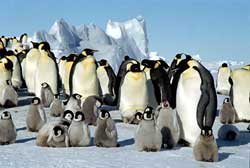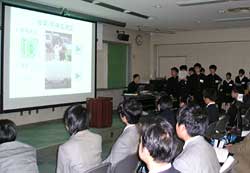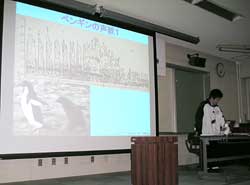|
MONTHLY NEWS Kids Design Antarctic Experiments | ||||||||||||
Have you ever wondered how a penguin that has been out hunting in the sea can find its own chicks among the thousands of penguins in its flock? If you could have researchers do an experiment for you in the Arctic or Antarctic, what kind of experiment would you like them to do? A unique contest took place at the end of 2004 in which Japanese middle and high school students presented their ideas for experiments in the Arctic and Antarctic. The groups who made outstanding proposals were recognized at an award ceremony held on December 18, 2004, at the National Institute of Polar Research in Tokyo. The contest was held in connection with the fourth International Polar Year, which is scheduled to take place from 2007 to 2008. The purpose of the IPY is to raise awareness about the importance of international cooperation in conducting research in the vast and harsh polar environments. Both the IPY and Japanese Antarctic Research Expeditions have long histories. The first IPY was held as far back as 1882-1883, and Japanese research in the Antarctic has been conducted since the time of the third IPY, which took place in 1957-1958. Since then various activities have been held in the polar regions, including observing auroras, researching polar animals, and excavating through layers of ice to learn about the environment of the earth thousands of years ago. The forty-sixth Japanese Antarctic Research Expedition, which left Japan in November 2004, will actually conduct the top award-winning experiments from the contest. In the contest, therefore, the judges strictly examined each idea to gauge whether it was constructed in a logical manner and whether it could actually be carried out.
Three groups won top prizes. One is a science experiment group at Maebashi Daiyon Junior High School in Gunma Prefecture, the only middle school to receive a top prize. The students designed experiments based on the questions that came into their minds after learning about sonic speed (the speed of sound) and gravity in science class. The experiment was chosen because the children asked such straightforward questions, such as: The children learned that the speed of light is affected by temperature; is the speed of light in extremely cold regions calculated by a different formula than in other parts of the world? They were taught that gravity becomes stronger as you approach the poles; does that mean that the sand in an hourglass falls at a different rate in the Antarctic? The Tochigi Prefectural Utsunomiya Industrial High School won a top prize for its idea to monitor pollution levels of the earth's oceans by analyzing the droppings and body fat of penguins. Because of the way the winds and oceans flow on the earth, the Antarctic is said to attract pollutants from all over the world. The students proposed the experiment under the assumption that the season and oceanic currents affect the level of marine pollution. As a result, the experiment received high scores for its value and feasibility. The third school to receive a top prize was the Gifu Prefectural Gizan High School, which has been studying the shapes of snow and ice crystals. Learning that the shapes of snow crystals are affected by the temperature under which they form, the students came up with a snow-crystal experiment that can only be conducted in very cold environments. The children who proposed the experiments are eagerly waiting to find out the results.
Among the other winners was Izawa Yuto, a middle school student in Tokyo. He won a special prize for his proposal for a research project with penguins. Having seen penguin parents accurately find their own babies in the flock, Yuto thought, "There has to be a system behind it. I'll find out what it is." Thinking about it further, he guessed that humans might be able to use the system to communicate in times of disaster. The judges praised his idea as a research project that they hope will succeed in the future, although it would be difficult to put such applications to actual use today. |
 |


